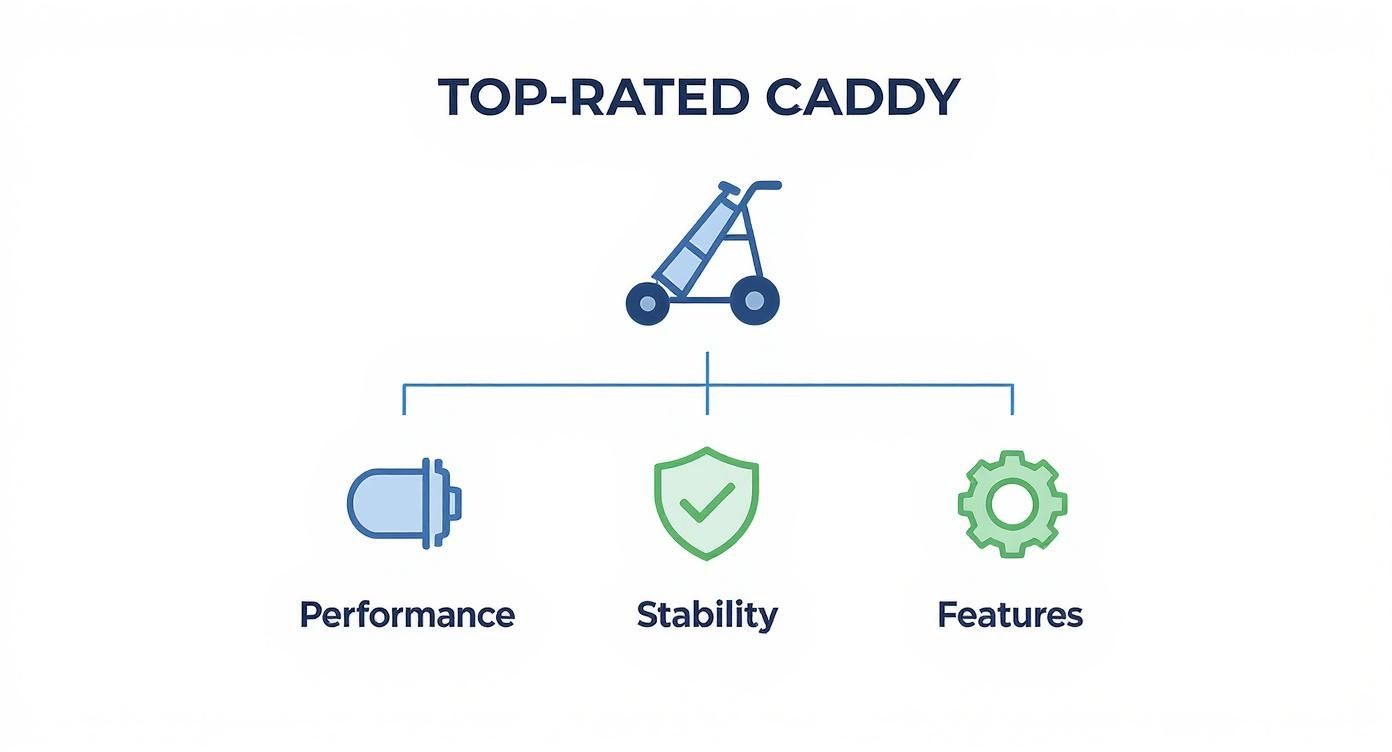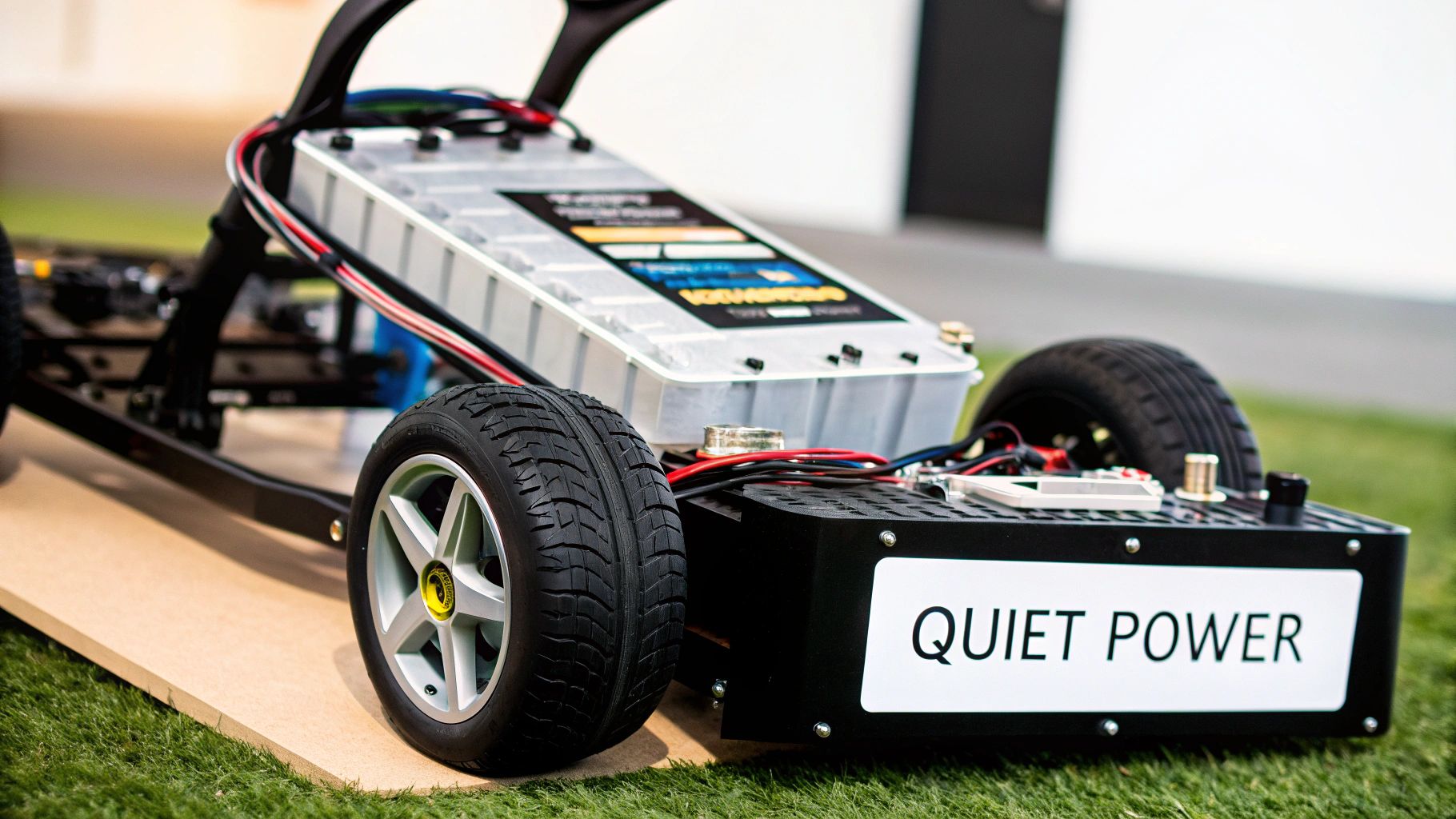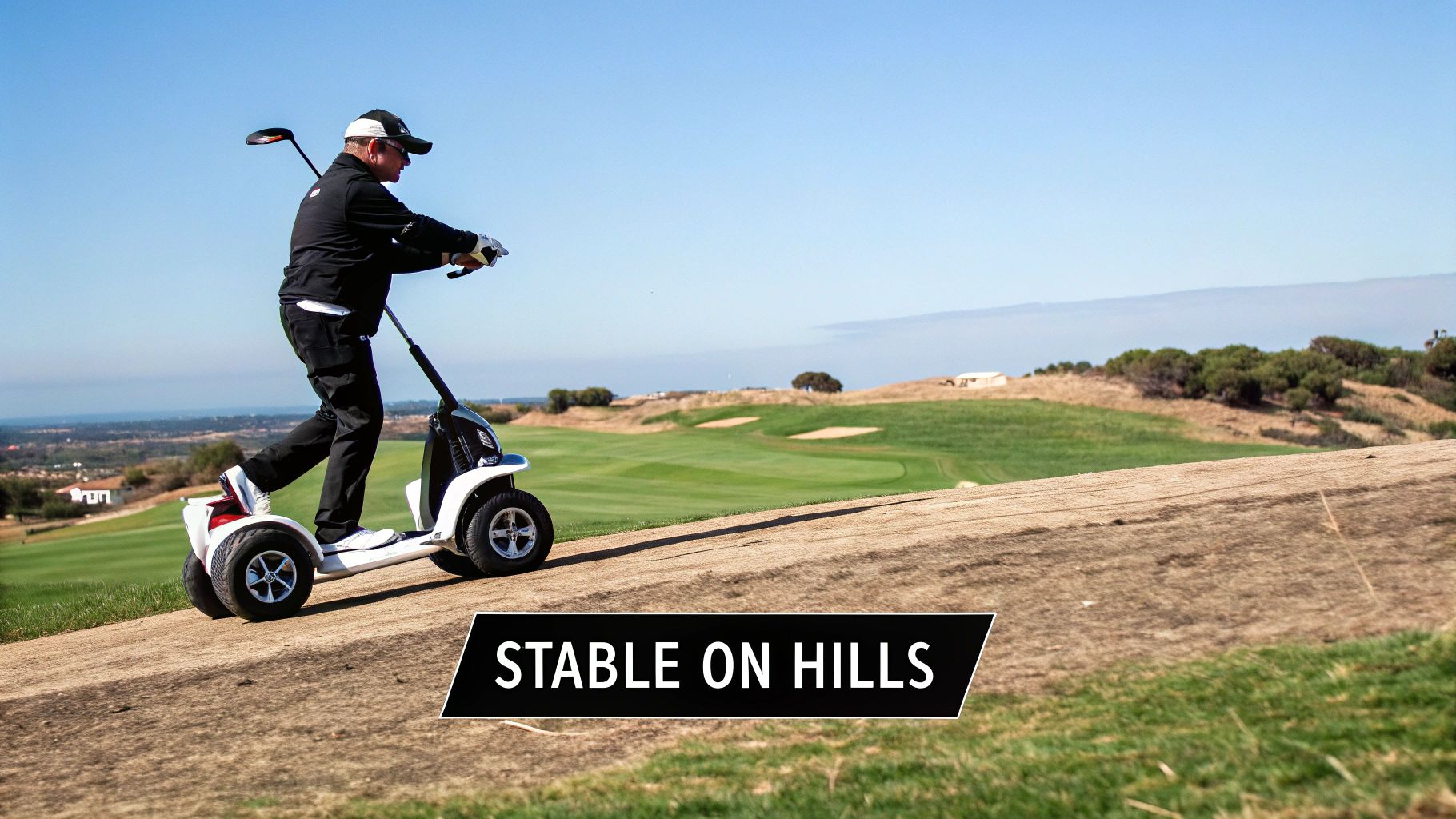What really separates a good electric golf caddy from a great one? It’s more than just a motor on a frame. The best, top-rated models are a seamless blend of smart design, rock-solid performance, and features that actually make a difference in your game.
Think of it less like a cart and more like a professional caddy. It’s there to conserve your energy, carry the load, and let you focus entirely on your next shot.
What Defines a Top Rated Electric Golf Caddy
So, what’s the secret sauce that elevates an electric golf caddy beyond just a brand name? A truly top-tier model feels like a natural extension of your game, not just a clunky gadget for your clubs. It’s the difference between a simple motorized cart and a reliable partner on the course.
This distinction is built on a few essential pillars that all work together to create an effortless, almost invisible experience.
At its core, any top-rated caddy has to deliver on three fundamental promises: unwavering performance, superior stability, and intelligent, user-friendly features. This trio is the foundation of a product that helps your game instead of becoming another distraction.
This infographic breaks down that core hierarchy perfectly.

As you can see, a quality caddy is the sum of its parts. Performance, stability, and smart features are all equally crucial for a great day on the course.
The Pillars of Excellence
The first pillar is robust performance, and that all comes down to the motor and battery. A top model silently cruises up steep inclines without a hint of struggle, powered by a long-lasting lithium battery that won’t die on you at the 16th hole. Consistent, reliable power from the first tee to the last is simply non-negotiable.
This growing demand for reliable power is actually driving major market growth. The electric golf trolley market was valued at USD 147.19 million and is expected to grow at a CAGR of 5.6% through 2032. This expansion is fueled by innovations like remote control and automatic braking that let golfers save their energy for what matters—the swing.
The best caddies operate almost silently, preserving the tranquility of your round. They provide power when you need it and fade into the background when you don't, allowing you to stay in the zone.
Next up is superior stability. A top-rated electric caddy navigates any terrain with total confidence—sidehills, bumpy fairways, and steep descents are no problem. Features like a low center of gravity, a wide wheelbase, and automatic downhill braking make sure your expensive clubs are always safe and secure. You can explore a variety of models and their specific stability features in our detailed electric push cart reviews.
Finally, smart features must be intuitive, not gimmicky. We’re talking about things like effortless remote controls, hands-free follow modes, and simple, one-click folding mechanisms that make the caddy a joy to use. These are the thoughtful details that separate a game-changing investment from a basic model that just carries your bag.
To make it even clearer, here's a quick breakdown of these essential attributes.
Quick Guide to Top Rated Caddy Attributes
| Attribute | Why It Matters for Your Game | What to Look For |
|---|---|---|
| Robust Performance | Frees you from pushing or carrying, saving energy for your shots. No more mid-round power anxiety. | A powerful, quiet motor and a high-capacity lithium battery that lasts 27-36 holes. |
| Superior Stability | Protects your gear on uneven ground and steep hills, so you can focus on your lie, not your cart. | A low center of gravity, wide wheelbase, and features like automatic downhill braking. |
| Smart, Intuitive Features | Makes the caddy feel like a seamless part of your game, not a complicated piece of tech you have to fuss with. | Easy-to-use remote controls, hands-free follow modes, and a simple, compact folding system. |
Ultimately, a top-rated caddy isn't just about having the most features; it's about having the right features that work flawlessly together, round after round.
The Powerhouse Under the Hood
Every top-rated electric golf caddy has a secret weapon—its motor and battery. This duo is the heart and soul of the machine, dictating everything from its hill-climbing grit to how many holes it can handle. It’s the difference between a caddy that sputters out on the back nine and one that finishes 36 holes with power to burn.
Think of the motor as the caddy’s muscles. A weak motor will whine and strain on steep inclines or get bogged down in thick, wet grass. A high-quality motor, on the other hand, delivers what’s known as quiet power. It’s an effortless performance that operates almost silently, so the only thing you hear is the game.
That quiet strength is what keeps your focus on the next shot, not on whether your caddy can make it up the fairway.
The Heartbeat of Performance: The Battery
If the motor provides the muscle, the battery is the heart, pumping steady energy all through your round. The technology here has come a long way. Older models relied on heavy, slow-charging lead-acid batteries, but today, the gold standard for any serious caddy is lithium-ion.
The advantages are pretty clear:
- Lighter Weight: Lithium-ion batteries are a fraction of the weight, which makes the caddy much easier to lift, transport, and steer.
- Faster Charging: They recharge in a few hours, not overnight. That means less downtime between rounds.
- Consistent Power: Unlike old batteries that get weaker as they drain, a lithium-ion battery delivers steady power from the first tee to the final putt.
- Longer Lifespan: A quality lithium battery is usually rated for 500-1000+ charge cycles, giving you years of reliable service.
This is the tech that actually makes a "36-hole battery" a reality.
What a 36-Hole Battery Really Means
While "36-hole battery" is the benchmark you'll see everywhere, real-world mileage can vary. Hilly courses, wet turf, and a heavy tour bag all demand more juice from the battery, which can shorten its range. A top-rated electric caddy is engineered with a quality lithium battery specifically to handle these variables and still comfortably complete two full rounds under normal conditions.
To keep your caddy running strong for years, a little battery care goes a long way. You can find some great general tips for boosting electric vehicle battery life that apply here, too. Good charging habits are the easiest way to protect your investment.
A great battery doesn't just last longer—it delivers reliable, fade-free power. This means your caddy is just as strong on the 18th hole as it was on the 1st, giving you one less thing to worry about.
The motor and battery have to work in perfect sync. The motor gives you the raw torque needed for tough terrain, while the battery supplies the endurance for those long days on the links. You can dive deeper into how these two components power your game in our guide to understanding golf push cart motor power.
Ultimately, the powerhouse under the hood is all about reliability and confidence. It’s knowing your caddy has the strength to tackle any hill and the stamina to go the distance, letting you walk the course with total freedom and focus. This powerful combination is a non-negotiable feature in any caddy that truly earns the "top-rated" title.
Mastering Any Terrain with Confidence
A top-rated electric golf caddy does more than just carry your clubs; it gives you the confidence to tackle any part of the course. Picture yourself walking a steep, slick sidehill, completely sure that your expensive gear isn't about to take a tumble. That feeling of security comes from smart engineering focused on one thing: stability.
This isn't about luck. It's about a design that turns a simple carrier into a trustworthy partner on every hole. When you stop worrying about your equipment, you can finally focus completely on your game.

Building a Foundation of Stability
The secret to a tip-proof caddy isn't all that complicated. It boils down to two key physical traits: its center of gravity and its wheelbase. A low center of gravity keeps the caddy glued to the ground, much like how a race car hugs the track to stay stable at high speeds. This simple principle prevents it from getting top-heavy and tipping over on awkward lies.
Just as critical is a wide wheelbase. The bigger the distance between the wheels, the more stable the platform. It's a simple concept that creates a solid base, resisting the urge to tip, especially when you're cutting across a slope instead of just going straight up or down. These two elements work together to create a rock-solid foundation for your golf bag.
The push for better design is getting a boost from the wider world of electric transportation. The global electric golf cart market, valued at around USD 1.414 billion, is expected to hit nearly USD 2.154 billion by 2035. This boom, driven by a love for quieter and more efficient electric models, has sparked big improvements in battery tech and vehicle stability. You can dive deeper into these market trends over at Future Market Insights.
Three Wheels vs. Four Wheels
One of the biggest debates you'll see is whether three or four wheels are better. Honestly, each setup has its own distinct advantages, and the best choice really depends on the kind of courses you play.
-
Three-Wheel Caddies: These are the nimble acrobats of the caddy world. That single front wheel gives them a super tight turning radius, making it a breeze to weave around trees, bunkers, and other tight spots. The trade-off? On extremely rough or slanted ground, that agility can sometimes come at the cost of pure stability.
-
Four-Wheel Caddies: With a larger footprint, these are the undisputed champions of stability. Four points of contact with the ground create a rock-solid base that just won't quit, which is perfect for hilly courses and bumpy fairways. Their turning radius might be a bit wider, but that sure-footed feel is a trade-off many golfers are happy to make for peace of mind.
Ultimately, the decision between three and four wheels is a choice between nimble maneuverability and unshakable stability. A top rated electric golf caddy will be a master of its class, whether it's a perfectly balanced three-wheeler or a fortress-like four-wheeler.
Advanced Braking and Balance Systems
Beyond the physical frame, modern tech adds another layer of control and safety. These smart systems are actively working to keep your caddy upright and in check, especially when you need it most.
One of the most important features is automatic downhill braking. This technology is a lifesaver on steep descents, preventing your caddy from getting away from you. The motor automatically kicks in to maintain a slow, controlled speed, so you can walk down a hill confidently instead of chasing a runaway cart. It's basically cruise control for slopes.
Some of the higher-end models take things a step further with gyroscopic stabilization systems. Internal sensors detect when the caddy starts to tilt and make tiny adjustments to the wheels to keep everything balanced. It’s the same kind of tech that keeps drones level in the air, but here it’s protecting your clubs on the ground. Features like these ensure your caddy moves with a secure grace that lets you focus on your next shot, not your equipment.
Smart Features That Actually Help Your Game
Let’s be honest, modern electric caddies have become far more than just souped-up club carriers. The top rated electric golf caddy today is more like an intelligent assistant, packed with smart technology that’s genuinely designed to help you play better.
These aren't just flashy gadgets. They're functional tools meant to clear your head so you can focus on one thing: your swing.
This trend is everywhere in golf. Just look at the U.S. market for golf carts, where Battery Electric Vehicles (BEVs) now dominate with a massive 72.5% share. Golfers are demanding smarter, more reliable electric options, and that preference has absolutely spilled over into the world of personal caddies. You can dig into more of this data in GlobeNewswire's market analysis on mobility trends.

Tiers of Intelligent Control
Not all "smart" caddies are built the same. The level of control you get can vary wildly between models, and it usually breaks down into a few distinct tiers. Knowing the difference helps you figure out what you actually need.
At the most basic level, you have a simple handle-mounted dial or digital display. This setup lets you manually set the speed to match your walking pace. It works, but it means you always have to keep one hand on the caddy, which can get old over 18 holes.
The next step up—and it’s a big one—is a handheld remote control. This is where you get a real taste of freedom. You can send your caddy ahead to the next tee while you walk over to mark your ball on the green. It completely untethers you from the handle.
The Ultimate Freedom: Follow Mode
The absolute peak of caddy technology, though, is Follow Mode. This is where the machine stops feeling like a cart you’re operating and starts feeling like a true robotic companion. For many golfers, it’s a total game-changer.
So how does it work? You clip a small transmitter to your belt or back pocket. The caddy then uses a combination of signals—like Bluetooth and ultrasound—to lock onto your position and follow you from a set distance. It’s that simple.
The payoff is huge:
- Total Focus: You can walk the fairway, line up putts, and think about your next shot without ever touching or even thinking about your gear.
- Natural Pace: The caddy just goes when you go. It automatically matches your speed, whether you're strolling or picking up the pace.
- Reduced Mental Load: It might seem small, but not having to steer a remote frees up a surprising amount of mental energy for the game itself.
Follow Mode isn't just a cool feature; it’s about creating an experience so seamless it’s almost invisible. A top-tier caddy with this tech lets you enjoy the walk like a tour pro, completely immersed in your round.
To see how these features stack up in the real world, let's look at how the Caddie Wheel compares to some of the other top models on the market.
Feature Comparison: Caddie Wheel vs. Other Top Models
While Follow Mode is a standout feature, it's the combination of smart tech and performance that separates the best from the rest. Here's a quick look at how Caddie Wheel stacks up against two other leading competitors.
| Feature | Caddie Wheel | Competitor A | Competitor B |
|---|---|---|---|
| Control System | Remote Control & Follow Mode | Remote Control Only | Handle-Mounted Controls |
| GPS Integration | Yes (via App) | Yes (Built-in Display) | No |
| Battery Life | 27-36 Holes | 27 Holes | 18 Holes |
| Weight | 9 lbs | 15 lbs | 12 lbs |
| Hill Assist | Automatic Braking | Manual Braking | Limited |
| Price Point | $$ | $$$$ | $$$ |
As you can see, different models prioritize different things. While Competitor A offers a built-in screen, the Caddie Wheel focuses on a lightweight design and longer battery life, making it a more practical choice for many golfers.
Onboard Intelligence and GPS Integration
Beyond just following you around, the best caddies are now becoming on-course information hubs. Smart integrations, often displayed right on the handle, can give you crucial data when you need it most.
Here are some of the most valuable features you’ll find:
- Built-in GPS: High-end models often come preloaded with thousands of courses, giving you accurate yardages to the front, middle, and back of the green.
- Score Tracking: Forget the pencil and paper. You can enter your score right on the caddy’s screen after each hole.
- Distance to Pin: Some advanced GPS systems can even give you a precise measurement to that day's pin location, taking the guesswork out of club selection.
- Shot Measurement: Want to know how far you really hit that drive? This feature lets you track your shot distances to better understand your game.
These tools do more than just spit out numbers. They streamline your whole routine on the course. Instead of fumbling with a rangefinder, a scorecard, and your phone, all your key info is in one place. That kind of smart consolidation is what truly defines a top rated electric golf caddy—it simplifies the process so you can focus on playing your best.
Why Caddie Wheel Is a Leader in the Field
Knowing what makes a great electric caddy is one thing. Seeing it all come together in a real-world product is another. Caddie Wheel is a perfect example of what happens when you nail the fundamentals we’ve talked about—power, stability, and smart design—in a way that just makes sense for the average golfer.
This isn’t about cramming in every feature under the sun. It's about how the right features come together to solve the annoying little problems we all face on the course, letting you focus on your game.

Uncompromising Power and Endurance
Remember our talk about the "powerhouse under the hood"? That’s the entire philosophy behind Caddie Wheel’s design. The advanced lithium-ion battery isn't just a component; it’s the heart of the machine, built to give you consistent, fade-free power for up to 36 holes.
This directly tackles the number one fear every electric caddy owner has: running out of juice on the back nine. Plus, the battery is incredibly light, weighing just a few pounds, so it doesn't add a bunch of dead weight to your cart. This combination means you can confidently send your cart up steep, wet fairways knowing it has the muscle to get there, from the first tee to the 18th green.
Intelligent Control That Keeps You Focused
Smart features should make life simpler, not more complicated. Caddie Wheel absolutely nails this with its intuitive remote. You get forward, reverse, and brake functions right at your fingertips. No confusing screens, no cycling through menus—just simple, immediate control that lets you stay locked in on your next shot.
This wasn't an accident; it's a deliberate design choice. By stripping away the unnecessary bells and whistles, Caddie Wheel ensures you’re spending your mental energy reading the green, not troubleshooting your gear.
Caddie Wheel’s approach is a masterclass in functional simplicity. It proves that the smartest feature is often the one you don't have to think about at all, allowing the technology to blend seamlessly into the background of your game.
Solving Real-World Golfer Problems
A product truly earns its stripes as a top-rated electric golf caddy when it solves actual problems golfers face. Caddie Wheel was clearly designed by golfers, for golfers, and it shows in every detail.
- Compact & Universal Design: Let's be honest, compatibility and transport are huge headaches. Caddie Wheel’s simple drop-on attachment system lets you convert most standard three- and four-wheel push carts into a powerful electric model in just a few minutes. No need to buy a whole new, bulky cart.
- Effortless Transportation: Because it's a modular unit, getting the Caddie Wheel to the course is a breeze. You can pop it off your cart and store it separately, making it a perfect fit for smaller car trunks where a full-sized electric caddy wouldn't stand a chance.
- Accessible Performance: Many high-end electric caddies have price tags that put them out of reach for most players. Caddie Wheel delivers the core benefits—motorized power, remote control, and a 36-hole battery—at a much more friendly price point. It opens up the electric experience to a lot more golfers.
This focus on practical solutions is what makes the product stand out. If you want to see exactly how it works, you can explore the full specs of the Caddie Wheel unit and see how it attaches to different cart models.
A Design Built on Stability and Simplicity
The Caddie Wheel is engineered to preserve the stability you love about your push cart. By adding weight low and centered at the rear axle, it actually lowers the cart’s center of gravity. This makes it more balanced on sidehills and uneven ground. It's smart engineering that gives you all the perks of power without sacrificing the steady base you rely on.
In a market often crowded with overly complex and heavy machines, Caddie Wheel’s leadership comes from its commitment to a simple, effective, and user-friendly solution. It doesn't try to do everything; it focuses on being the best at what matters most—giving you the freedom to walk the course effortlessly and play your best game.
Answering Your Top Electric Caddy Questions
Making a smart investment means asking the right questions first. Even after digging into all the features and benefits, you might still have a few practical concerns floating around in the back of your mind. That’s perfectly normal, and we're here to tackle those common questions head-on.
We’ll give you clear, straightforward answers to the things golfers wonder about most before they buy an electric caddy. The goal is to fill in those final gaps so you can make your choice with total confidence and find a model you’ll be happy with for years to come.
How Much Maintenance Does an Electric Caddy Need?
One of the biggest reliefs for new owners is finding out just how little upkeep a modern, top-rated electric caddy actually needs. Gone are the days of constant tinkering. Today’s best units are built for reliability and minimal fuss.
Your maintenance routine is refreshingly simple. The most important jobs are basic cleaning and proper battery care. After a round, especially a wet one, it’s smart to wipe down the frame and wheels to get rid of any mud or grass clippings. This stops gunk from building up and affecting moving parts down the road.
As for the battery, the golden rule is to follow the manufacturer's charging instructions. Most lithium-ion batteries perform best when they aren't left completely dead for long stretches. Just get into the habit of charging it after each round, and it’ll stay healthy and ready for your next tee time.
Are Remote and Follow Features Worth the Cost?
This is less about cost and more about the experience. A basic electric caddy is great—it frees you from pushing. But a model with remote control or a Follow Mode completely changes how you interact with the course. It shifts you from being a caddy "operator" to just being a golfer.
Think about the mental energy you spend steering a cart, even with a remote. Now, imagine redirecting all of that energy to your next shot. That’s the real value of Follow Mode. It creates a truly hands-free round, letting you walk the fairway, think about your approach, and stay in the zone without giving your gear a second thought.
For golfers who play hilly courses or who want to conserve every ounce of physical and mental stamina, these advanced features are not a luxury—they are a direct investment in your performance and enjoyment.
They turn the walk between shots into a moment of focus and relaxation, which is something a lot of players find is worth every penny.
How Easy Is It to Transport an Electric Caddy?
Portability is a huge deal, and the makers of the top rated electric golf caddy models have made it a top priority. Forget about those bulky, awkward machines that barely squeezed into an SUV. Today's designs are all about convenience.
Most high-quality caddies have intuitive, one-click folding mechanisms that collapse them into a surprisingly small package in just seconds. They're also built with lightweight materials like aluminum or carbon fiber, making them much easier to lift into a car trunk. For instance, some units weigh as little as 9-12 lbs, not including the battery.
Here's a great tip before you buy: measure your trunk space and check it against the folded dimensions listed for the caddy you're eyeing. This one simple step guarantees a perfect fit and a stress-free trip to the course.
What Is the Real-World Lifespan of the Battery?
Let's cut right to it. The lifespan of a modern lithium-ion battery isn’t measured in months or years, but in charge cycles. A high-quality battery, like the ones in top-rated caddies, is typically rated for 500 to 1,000+ full charge cycles.
So, what does that actually mean for you? If you play golf once a week and charge the battery after every round, a battery rated for 800 cycles could last you for over 15 years. For the average golfer playing 50-100 rounds a year, this translates to a reliable lifespan of at least five to eight years, and often much longer.
To get the most out of it, just stick to a few best practices:
- Charge after each use: Don't let the battery sit completely drained.
- Use the correct charger: Always stick with the charger that came with your unit.
- Store it properly: Keep the battery in a cool, dry place when you're not using it.
By following these simple tips, you can make sure your caddy’s powerhouse performs reliably for thousands of holes.
Ready to experience the freedom of a truly effortless round of golf? The Caddie Wheel delivers the power, control, and reliability discussed here in a simple, universal design.
Upgrade Your Game Today with Caddie Wheel


Share:
Your Guide to the Stewart Golf Cart
Your Guide to the Modern Golf Power Cart